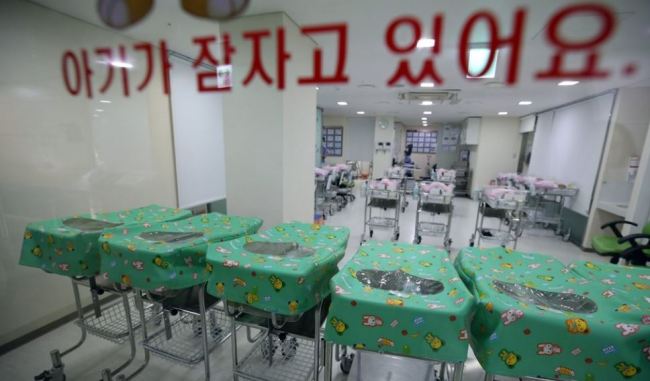Number of newborns with birth defects on the rise in Korea, possibly due to air pollutants: study
By Claire LeePublished : May 23, 2018 - 10:12
The number of newborns with birth defects has increased significantly in South Korea from 2008-2014, possibly due to pregnant women’s increased exposure to air pollutants and endocrine disruptors, a research showed on Wednesday.
The study by Inha University researchers, came to the conclusion after analyzing the National Health Insurance data on 3,208,617 newborns born 2008-2014.
Their research showed that the number of newborns with birth defects increased by 67 percent during the time period. In 2014, 563 out of 10,000 newborns were born with birth defects in South Korea, up from 336 per 10,000 back in 2008.
The study by Inha University researchers, came to the conclusion after analyzing the National Health Insurance data on 3,208,617 newborns born 2008-2014.
Their research showed that the number of newborns with birth defects increased by 67 percent during the time period. In 2014, 563 out of 10,000 newborns were born with birth defects in South Korea, up from 336 per 10,000 back in 2008.

Among all birth defects reported in the 2008-2014 period, atrial septal defect -- a heart defect that involves a hole in the wall between the two upper chambers of the heart -- had one of the highest increase rates. The prevalence rate of the abnormality increased by 2.7 times from 82.2 per 10,000 to 188.9 per 10,000.
Other defects that had significantly high increase rates include congenital hip dislocation (41.8 per 10,000 to 103.7 per 10,000), cystic kidney disease (0.43 per 10,000 to 2 per 10,000), a genetic condition characterized by the growth of fluid-filled cysts that may result in malformed kidneys and cryptorchidism (45.6 per 10,000 to 74.3 per 10,000), a condition characterized by undescended testis.
A previous study by the same university showed that hypospadias -- a birth defect of the urethra where the urinary opening is not on the head of the male genital -- had the highest increase rate of all birth defects reported from 1993-2010, from 0.7 per 10,000 to 9.9 per 10,000.
Citing past overseas research, the Inha University scholars suggested the increasing number of defects in the Korean newborns’ genital and urinary systems, such as hypospadias and cryptorchidism, may have been triggered by pregnant women’s exposure to traffic-related air pollutants and endocrine disruptors such as Bisphenol A, which is used to make plastics.
“Previous studies have suggested that the prevalence of undescended testis increased during the past half century in industrialized countries,” the paper noted.
A 2013 study by Stanford University School of Medicine also found an association between traffic-related air pollutants and malformations of the brain of newborns in California.
The 2016 study by Inha University also suggested that exposure to endocrine disruptors -- chemicals that, at certain doses, can interfere with the hormone system in humans -- may have increased the number of newborns with birth defects in Korea. According to the paper, chemicals such as Bisphenol A, mycotoxins and pesticides have been reported to affect human pregnancies.
A study published in 2015 by European Urology also found that pregnant women who are exposed to endocrine disrupting chemicals at work, such as hairdressers, laboratory workers and cleaners, are more likely to have baby boys with a genital defect.
Professor Lim Jong-han, who led the Inha University study on birth defects, also stressed that congenital birth defects are considered a main cause of death among newborns in South Korea.
South Korea ranked 166th out of 180 countries in terms of air quality, according to the Environmental Performance Index this year, becoming one of the poorest performers among Asian countries.
By Claire Lee (dyc@heraldcorp.com)







![[Graphic News] More Koreans say they plan long-distance trips this year](http://res.heraldm.com/phpwas/restmb_idxmake.php?idx=644&simg=/content/image/2024/04/17/20240417050828_0.gif&u=)
![[KH Explains] Hyundai's full hybrid edge to pay off amid slow transition to pure EVs](http://res.heraldm.com/phpwas/restmb_idxmake.php?idx=644&simg=/content/image/2024/04/18/20240418050645_0.jpg&u=20240419100350)







![[KH Explains] Hyundai's full hybrid edge to pay off amid slow transition to pure EVs](http://res.heraldm.com/phpwas/restmb_idxmake.php?idx=652&simg=/content/image/2024/04/18/20240418050645_0.jpg&u=20240419100350)

![[Today’s K-pop] Illit drops debut single remix](http://res.heraldm.com/phpwas/restmb_idxmake.php?idx=642&simg=/content/image/2024/04/19/20240419050612_0.jpg&u=)